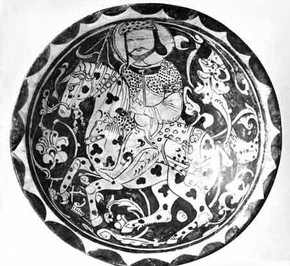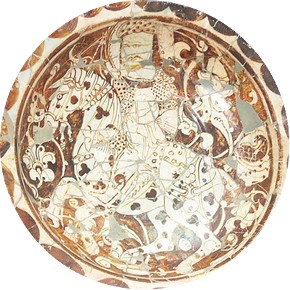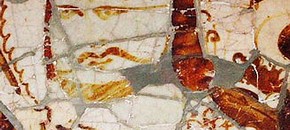My research log began as a way to document and answer my initial research questions, and I continue to delve deeper into a select few in my podcast in order to give them the depth that they deserve. Casting my net wide, I initially came up with a broad range of topics that I thought could illuminate some interesting details about my object:
Form
The form of my podcast is audio-visual, with my voice-over alongside complimenting imagery and videos to support my argument and show my image in further depth. I begin the introduction and conclude the podcast with a brief feature of Arabic muwashshahah music from the 13th century, however decided not to use this throughout the duration of the podcast. This was mainly to minimise distraction and ensure clarity of voice throughout the duration. In addition, because of changing imagery and videography in the podcast, I didn't want the audience's senses to be overwhelmed.
The main bulk of my video and imagery has come from primary sources and my own filming of the object and related pottery in the Oriental Museum. This was an amazing and unique opportunity to have and I really appreciated the chance on this module to have some hands-on time with the objects themselves to fully see up close the mastery in person. However, it did come with some difficulty as the fragile nature of the bowl meant I had to be very careful with it and this combined with getting steady footage did come as a challenge.
Secondary imagery that I used has mainly been taken from online sources (Google Arts and Cultures), the Metropolitan Museum and V&A and documentation from the National Arts Fund.
Content
My podcast begins with a title page, and Arabic music, shortly moving into a description of my object and reasoning behind choosing it. This music is calming, slow and religious in nature to reflect my object, and only carries on through the introduction in order to remove the risk of being too distracting - a problem I found in a few of the other podcasts that I had watched. I then move to a historical exploration of the previous owner of the pot, and how my object came to be in Durham. This is backed by images of the documentation between the National Arts Fund and Durham Oriental museum to show the nature of the transaction.
Following this I quickly bring into consideration the 8 other bowls in the bequest to begin a brief introductory comparison. I then begin a description of the techniques used to create the bowls illustrating the point with video footage of a potter making a pot out of fritware. I then go on to discuss the history of the techniques and how, at the beginning of the 12th century new pathways were opened up to artists due to new technology and knowledge, allowing a greater colour scheme.
Having explored some background knowledge about the craft, I go on to specifically cover the themes that I set out in my research questions. These include Imagery, Geometry, Arabesque and Calligraphy in Islamic Art. I decided to section each theme carefully, in order that the background imagery match well and to give a more chronological order to my podcast. In addition, I have tried to specifically reference their relation to my object and comparison objects in order to allow the audience to clearly see my points.
My podcast concludes with a reference to the contemporary value of the pots in the Durham Henry Van Der Bergh bequest, and a look as to the reasons why. The podcast is finished in much the same way it started, with music in the background, in order to nicely round it off and bring a cyclical nature to its presentation.
I had to cut down my podcast a lot from the original research that I had garnered for it because of time limitations but I hope I made the right decisions in where the material should come from in the end for a nicely flowing and interesting talk. However, I was still able to at least touch on all my main Research Questions, whilst hopefully providing a good depth to my podcast too.
- Decorative themes
- Techniques
- History of Persian Ceramics - pre-Islamic art and the spread of Islam
- Colours
- Decorative motifs
- Calligraphy
Form
The form of my podcast is audio-visual, with my voice-over alongside complimenting imagery and videos to support my argument and show my image in further depth. I begin the introduction and conclude the podcast with a brief feature of Arabic muwashshahah music from the 13th century, however decided not to use this throughout the duration of the podcast. This was mainly to minimise distraction and ensure clarity of voice throughout the duration. In addition, because of changing imagery and videography in the podcast, I didn't want the audience's senses to be overwhelmed.
The main bulk of my video and imagery has come from primary sources and my own filming of the object and related pottery in the Oriental Museum. This was an amazing and unique opportunity to have and I really appreciated the chance on this module to have some hands-on time with the objects themselves to fully see up close the mastery in person. However, it did come with some difficulty as the fragile nature of the bowl meant I had to be very careful with it and this combined with getting steady footage did come as a challenge.
Secondary imagery that I used has mainly been taken from online sources (Google Arts and Cultures), the Metropolitan Museum and V&A and documentation from the National Arts Fund.
Content
My podcast begins with a title page, and Arabic music, shortly moving into a description of my object and reasoning behind choosing it. This music is calming, slow and religious in nature to reflect my object, and only carries on through the introduction in order to remove the risk of being too distracting - a problem I found in a few of the other podcasts that I had watched. I then move to a historical exploration of the previous owner of the pot, and how my object came to be in Durham. This is backed by images of the documentation between the National Arts Fund and Durham Oriental museum to show the nature of the transaction.
Following this I quickly bring into consideration the 8 other bowls in the bequest to begin a brief introductory comparison. I then begin a description of the techniques used to create the bowls illustrating the point with video footage of a potter making a pot out of fritware. I then go on to discuss the history of the techniques and how, at the beginning of the 12th century new pathways were opened up to artists due to new technology and knowledge, allowing a greater colour scheme.
Having explored some background knowledge about the craft, I go on to specifically cover the themes that I set out in my research questions. These include Imagery, Geometry, Arabesque and Calligraphy in Islamic Art. I decided to section each theme carefully, in order that the background imagery match well and to give a more chronological order to my podcast. In addition, I have tried to specifically reference their relation to my object and comparison objects in order to allow the audience to clearly see my points.
My podcast concludes with a reference to the contemporary value of the pots in the Durham Henry Van Der Bergh bequest, and a look as to the reasons why. The podcast is finished in much the same way it started, with music in the background, in order to nicely round it off and bring a cyclical nature to its presentation.
I had to cut down my podcast a lot from the original research that I had garnered for it because of time limitations but I hope I made the right decisions in where the material should come from in the end for a nicely flowing and interesting talk. However, I was still able to at least touch on all my main Research Questions, whilst hopefully providing a good depth to my podcast too.

















